Paper Menu >>
Journal Menu >>
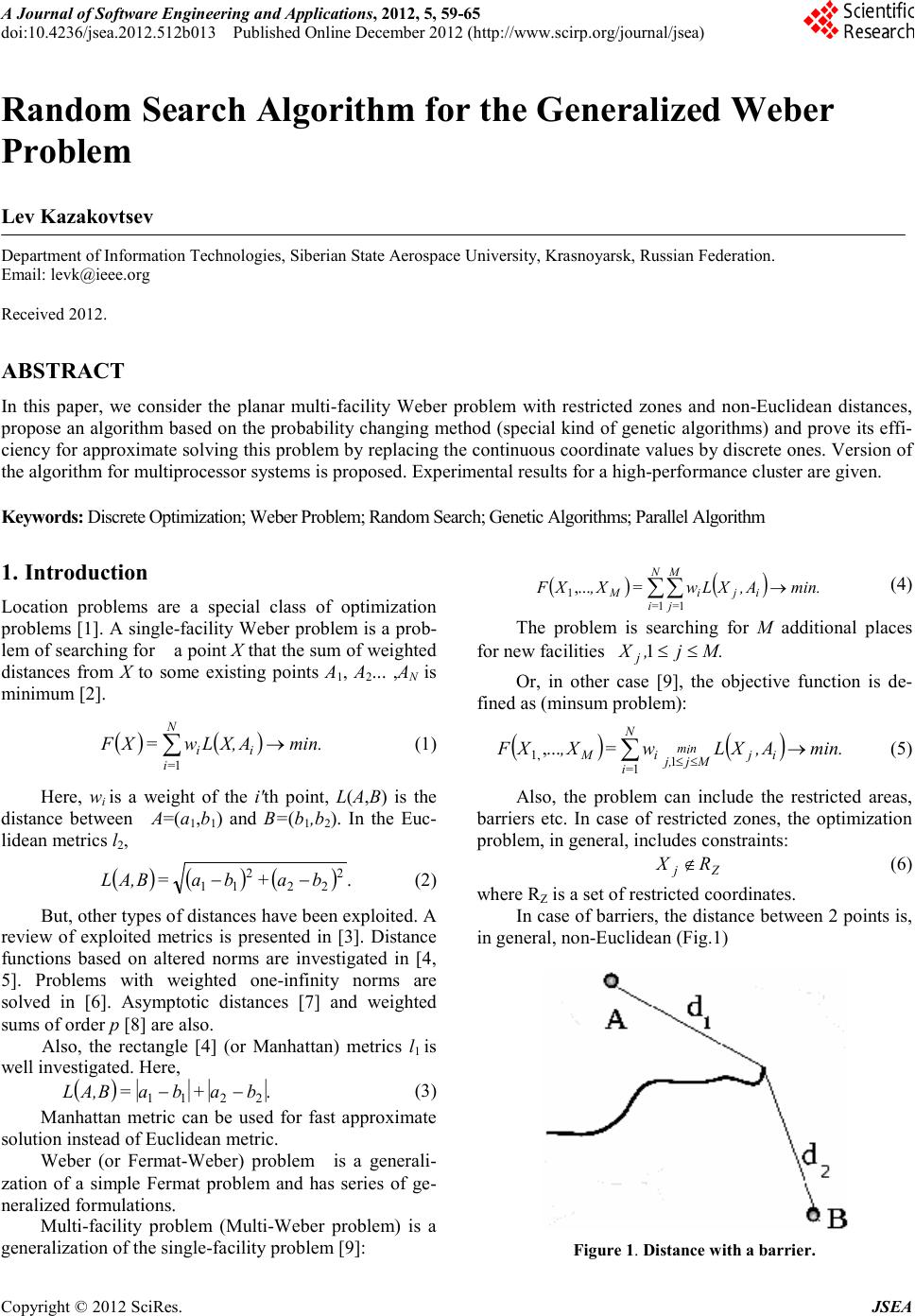 A Journal of Software Engineering and Applications, 2012, 5, 59-65 doi:10.4236/jsea.2012.512b013 Published Online December 2012 (http://www.scirp.org/journal/jsea) Copyright © 2012 SciRes. JSEA Random Search Algorit hm f or t he G eneral ized Weber Problem Lev Kazakovtsev Department of In formation Technologies, S ib erian State Aerospace U niversit y, Krasnoyarsk, Rus sian Federation. Email: levk@ieee.org Received 2012. ABSTRACT In this paper, we consider the planar multi-facility Weber problem with restricted zones and non-Euclidean distances, propose an algorithm based on the probability changing method (special kind of genetic algorithms) and prove its effi- ciency for approximate solving this problem by replacing the continuous coordinate values b y discrete ones. Ver sion of the al gorithm for multiprocessor systems is proposed. Experimental results for a high-perfor mance cluster are given. Keywords: Discrete Optimization; Weber Problem; Random Search; Gen eti c A lg or ith ms ; Parallel Algorithm 1. Introduction Location problems are a special class of optimization problems [1]. A single-facility Weber problem is a prob- lem of searching for a point X that the sum of weighted distances from X to some existing points A1, A2... ,AN is minimum [2]. ( )() min.AX,Lw=XF i N =i i → ∑ 1 (1) Here, wi is a weight of the i'th point, L(A,B) is the distance between A=(a1,b1) and B=(b1,b2). In the Euc- lidean metrics l2, ()() () . 2 22 2 11 ba+ba=BA,L−− (2) But, ot her t ypes of distances have been exploited. A review of exploited metrics is presented in [3]. Distance functions based on altered norms are investigated in [4, 5]. Problems with weighted one-infinity norms are solved in [6]. Asymptotic distances [7] and weighted sums of order p [8] are also. Also, the rectangle [4] (or Manhattan) metrics l1 is well investigated. Here, () || || . 2211 ba+ba=BA,L−− (3) Manhattan metric can be used for fast approximate solution instead of Euclidean metric. Weber (or Fermat-Weber) problem is a generali- zation of a simple Fermat problem and has series of ge- neralized formulations. Multi-facility problem (Multi-Weber problem) is a gener alization o f the sin gle -fac ility problem [9]: ( ) ( ) min.A,XLw=X,XF ij N =i M =j iM → ∑∑ 1 1 1 ..., (4) The problem is searching for M additional places for new facilities M.j,X j ≤≤1 Or, in other case [9], the objective function is de- fined as (minsum problem): ( ) ( ) min.A,XLw=X,XF ij n i mMjj, N =i iM → ≤≤ ∑1 1 1, ..., (5) Also, the problem can include the restricted areas, barriers etc. In case of restricted zones, the optimization problem, in general, includes constraints: Zj RX ∉ (6) where RZ is a set of restricted coor d inates. In case of barriers, the distance between 2 po ints is, in genera l , non-Euclidean (Fig.1) Figure 1 . Distance with a barrier. 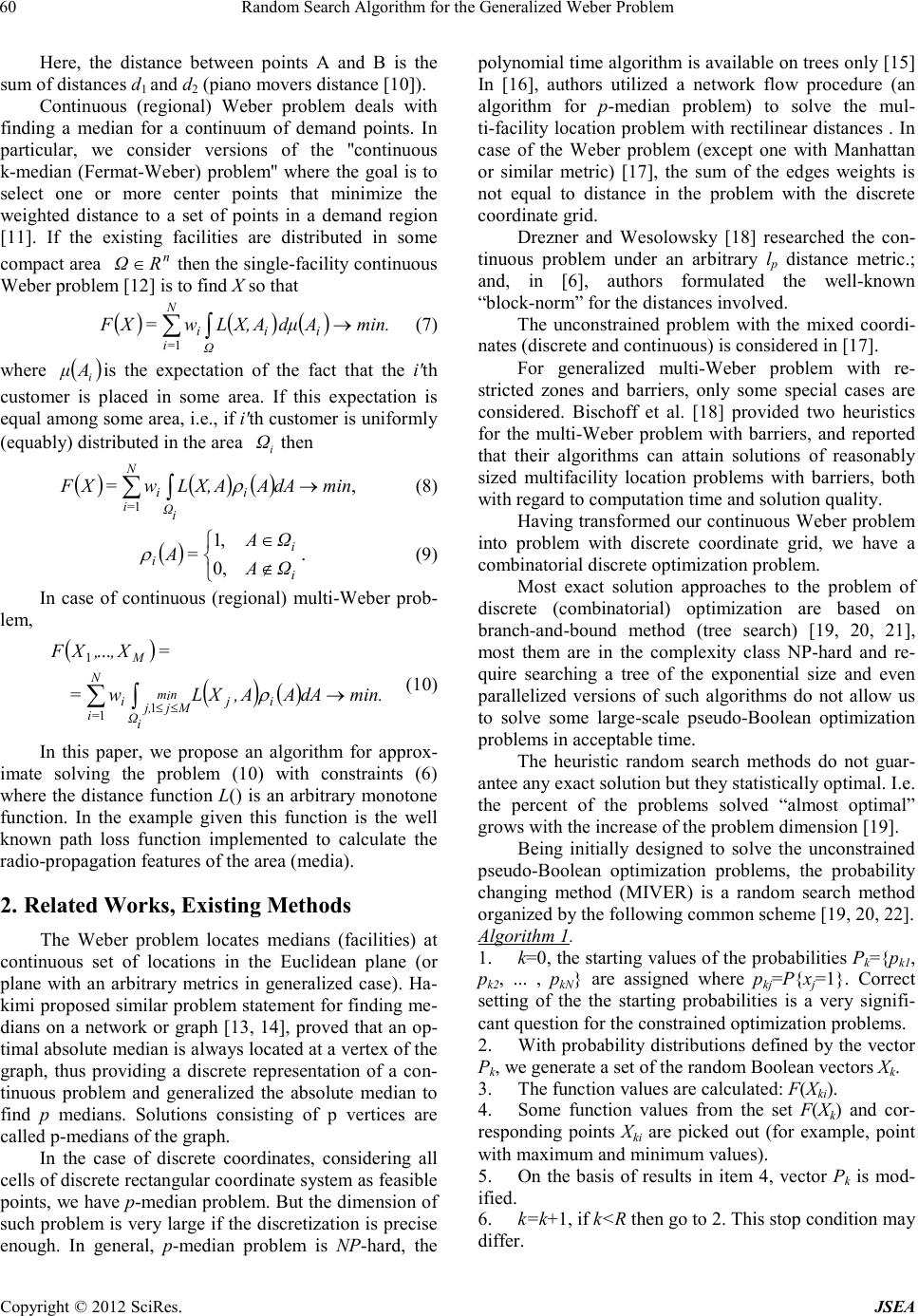 Random Search Algorithm for the Gen er alized Weber Problem Copyright © 2012 S ciRes. JSEA 60 Here, the distance between points A and B is the sum of di st ances d1 and d2 (piano movers distance [10]). Continuous (regional) Weber problem deals with finding a median for a continuum of demand points. In particular, we consider versions of the ''continuous k-median (Fermat-Weber) problem'' where the goal is to select one or more center points that minimize the weighted distance to a set of points in a demand region [11]. If the existing facilities are distributed in some compact area n RΩ∈ then t he si ngle -facility contin uous Weber problem [12] is to find X so that ( )()() min.AdμAX,Lw=XFii Ω N =i i→ ∫ ∑ 1 (7) where ( ) i Aμ is the expectation of the fact that the i'th customer is placed in some area. If this expectation is equal among some area, i.e., if i'th cust omer is uni for ml y (equably) distributed in the ar ea i Ωthen ()()() , 1 mindAAAX,L w=XF i i Ω N =i i → ∫ ∑ ρ (8) ( ) ∉ ∈ i i iΩA ΩA =A ,0 ,1 ρ . (9) In case of continuous (regional) multi-Weber prob- lem, ( ) ( ) ( ) min.dAAA,XLw= =X,,XF ij i Ω n i mMjj, N =i i M → ∫ ∑ ≤≤ ρ 1 1 1 ... (10) In this paper, we propose an algorithm for approx- imate solving the problem (10) with constraints (6) where the distance function L() is an arbitrary monotone function. In the example given this function is the well known path loss function implemented to calculate the radio-prop agation features of the area (media). 2. Related Works, Existing Methods The Weber problem locates medians (facilities) at continuous set of locations in the Euclidean plane (or plane with an arbitrary metrics in generalized case). Ha- kimi proposed similar problem statement for finding me- dians on a network or graph [13, 14], proved that an op- timal absolute median is always located at a vertex of the graph, thus providing a discrete representation of a con- tinuous problem and generalized the absolute median to find p medians. Solutions consisting of p vertices are called p-medians of the graph. In the case of discrete coordinates, considering all cells of discrete rectangular coord inate system as feasible poi nts, we have p-median problem. But the dimension of such prob lem is ver y large if the discretization i s pre cise enough. In general, p-median problem is NP-hard, the polynomial ti me algorith m is available o n trees onl y [15] In [16], authors utilized a network flow procedure (an algorithm for p-median problem) to solve the mul- ti-facility location problem with rectilinear distances . In case of the Weber problem (except one with Manhattan or similar metric) [17], the sum of the edges weights is not equal to distance in the problem with the discrete coordinate grid. Drezner and Wesolowsky [18] researched the con- tinuous problem under an arbitrary lp distance metric.; and, in [6], authors formulated the well-known “block-norm” for the distances involved. The unconstrained problem with the mixed coordi- nates (discrete and continuous) is considered in [17]. For generalized multi-Weber problem with re- stricted zones and barriers, only some special cases are considered. Bischoff et al. [18] provided two heuristics for the multi-Weber problem with barriers, and reported that their algorithms can attain solutions of reasonably sized multifacility location problems with barriers, both with r egard to computation ti me and solutio n quality. Having tra nsfor med our co ntinuous W eber pr oblem into problem with discrete coordinate grid, we have a combinatorial discrete optimization problem. Most exact solution approaches to the problem of discrete (combinatorial) optimization are based on branch-and-bound method (tree search) [19, 20, 21], most them are in the complexity class NP-hard and re- quire searching a tree of the exponential size and even parallelized versions of such algorithms do not allow us to solve some large-scale pseudo-Boolean optimization problems in acceptable time. The heuristic random search methods do not guar- antee any exact solution but they statistically optimal. I. e . the percent of the problems solved “almost optimal” grows with the increas e of the problem dimension [19]. Being initially designed to solve the unconstrained pseudo-Boolean optimization problems, the probability changing method (MIVER) is a random search method organize d by the followi ng commo n s cheme [19 , 20, 22]. Algorithm 1 1. k=0, the start ing values o f the prob abilities Pk={pk1, pk2, ... , pkN} are assigned where pkj=P{xj=1}. Correct setting of the the starting probabilities is a very signifi- cant question for the constrained optimization problems. . 2. With probability distributions defined by the vector Pk, we ge nerate a set of the rando m Boolean vectors Xk. 3. The functi on values are calculated: F(Xki). 4. Some function values from the set F(Xk) and cor- responding points Xki are picked out (for example, point with ma x i mu m and mini mu m va lues) . 5. On the basis of results in item 4, vector Pk is mod- ified . 6. k=k+1, if k<R then go to 2. This stop conditio n may diffe r. 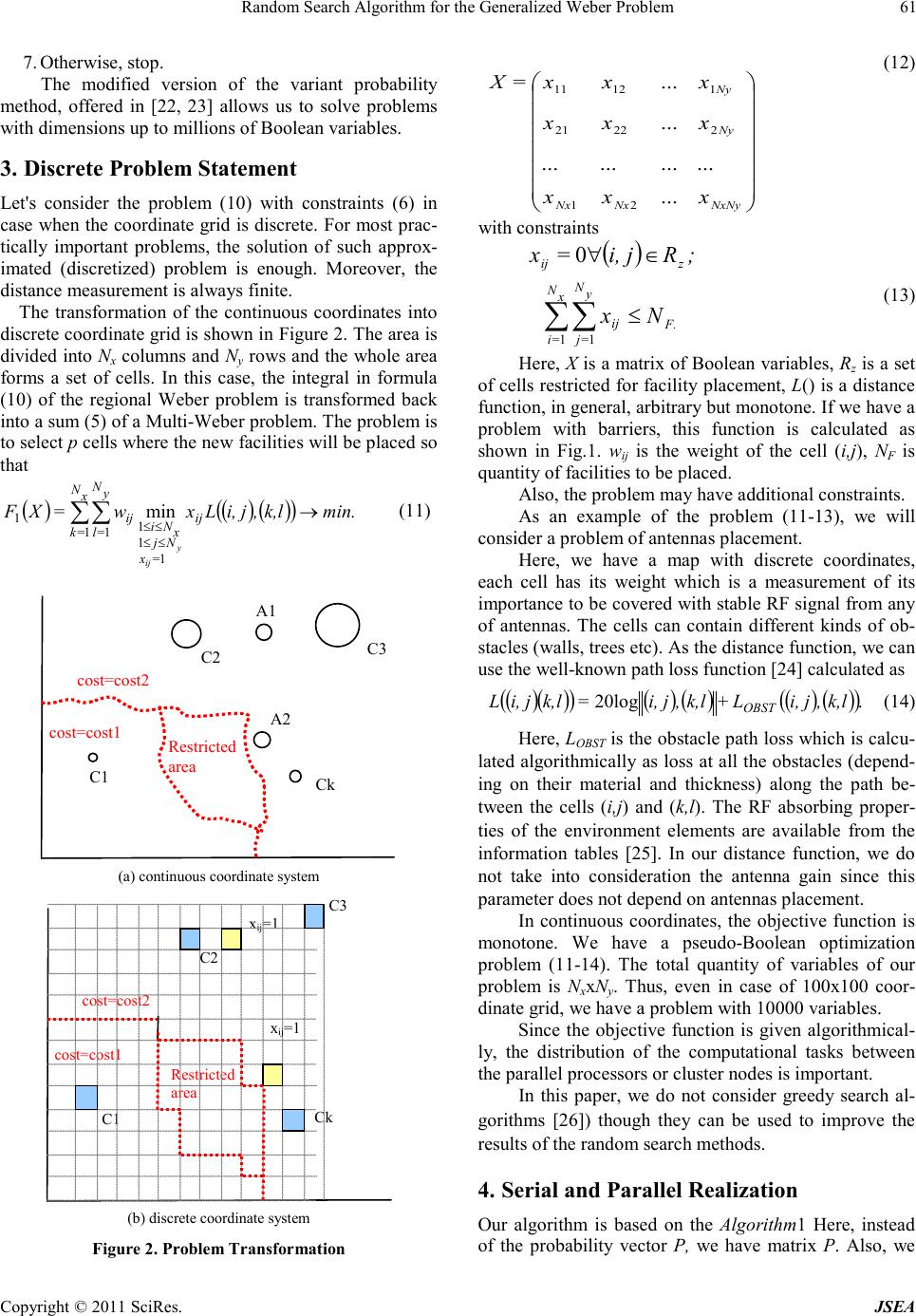 Random Search Algorithm for the Gen er alized Weber Problem Copyright © 2011 SciRes. JSEA 61 7. Otherwise, stop . The modified version of the variant probability method, offered in [22, 23] allows us to solve problems with dimensions up to millions of Boolean variables. 3. Discrete Problem Statement Let's consider the problem (10) with constraints (6) in case when the coordinate grid is discrete. For most prac- tically important problems, the solution of such approx- imated (discretized) problem is enough. Moreover, the distance measurement is always fi ni te. The transformation of the continuous coordinates into discrete co ordinate grid is sho wn in Fig ure 2 . T he a rea is divided into Nx columns and Ny ro ws and the whole area forms a set of cells. In this case, the integral in formula (10) of the regional Weber problem is transformed back into a sum (5) of a Multi-Weber problem. The problem is to select p cells where the new facilitie s will be plac ed so that ()()()() min.lk,,ji,Lxw=XF ij =x Nj x Ni x N =k y N =lij ij y → ≤≤ ≤≤ ∑∑ 1 1 1 1 1 1min (11) C1 C2 C3 Ck cost=cost1 cost=cost2 Restricted area A1 A2 (a) continuous coordina te system C1 C2 C3 Ck cost=cost1 cost=cost2 Restricted area xij=1 xij=1 (b) disc r ete c o ordinate system Figure 2. Problem Transformation NxNyNxNx Ny Ny xxx xxx xxx=X ... ............ ... ... 21 22221 11211 (12) with constrain ts ( ) F. x N =i y N =jij zij Nx ;Rji,=x ≤ ∈∀ ∑∑ 1 1 0 (13) Here, X is a matrix of Boolean variables, Rz is a set of cells restricted for fac ility place ment, L() is a dista nce functio n, in general, ar bitra r y but monotone. I f we have a problem with barriers, this function is calculated as shown in Fig.1. wij is the weight of the cell (i,j), NF is quantity of facilities to be placed. Also, the pro blem may have additio nal constraints. As an example of the problem (11-13), we will consider a problem of antennas placement. Here, we have a map with discrete coordinates, each cell has its weight which is a measurement of its importance to be covered with stable RF signal from any of antennas. The cells can contain different kinds of ob- stacles (walls, trees etc). As the distance function, we can use the well-known path loss function [24] calculated as ( )()()( )( )()()() .20loglk,,ji,L+lk,,ji,=lk,ji,L OBST (14) Here, LOBST is the obstac le path loss which is calcu- lated algorith mica lly as loss a t all the obstacles (depend- ing on their material and thickness) along the path be- tween the cells (i,j) and (k,l). The RF absorbing proper- ties of the environment elements are available from the information tables [25]. In our distance function, we do not take into consideration the antenna gain since this parameter does not depend on antennas placement. In continuous coordinates, the objective function is monotone. We have a pseudo-Boolean optimization problem (11-14). The total quantity of variables of our problem is NxxNy. Thus, even in case of 100x100 coor- dinate grid, we have a problem with 10000 variables. Since the objective function is given algorithmical- ly, the distribution of the computational tasks between the parallel processors or cluster nodes is important. In this paper, we do not consider greedy search al- gorithms [26]) though they can be used to improve the results of the random searc h methods. 4. Serial and Parallel Realization Our algorithm is based on the Algorithm1 Here, instead of the probability vector P, we have matrix P. Also, we 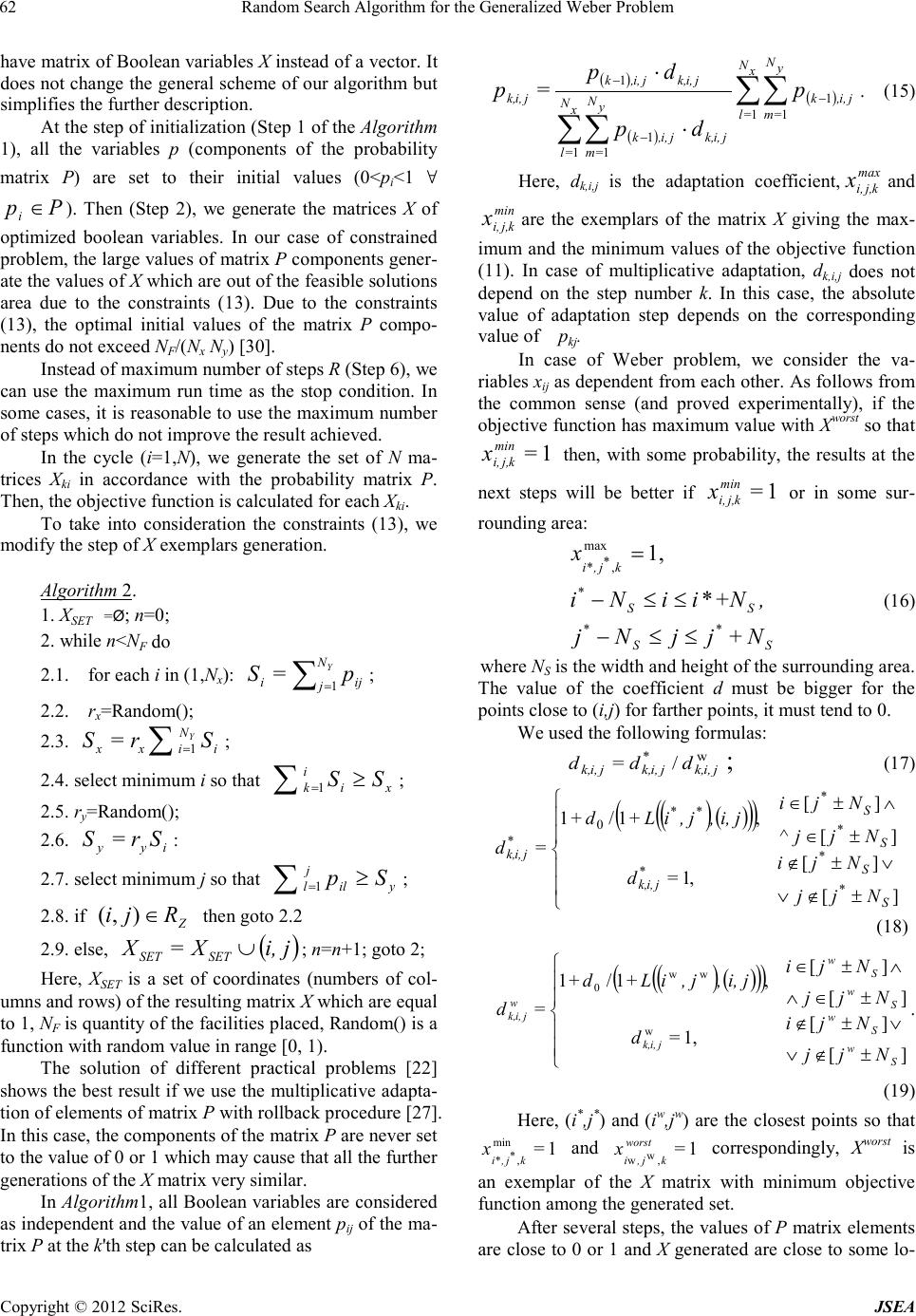 Random Search Algorithm for the Gen er alized Weber Problem Copyright © 2012 S ciRes. JSEA 62 have matrix of Boolean variables X instead of a vector. It doe s not cha nge t he ge neral s cheme of our a lgor ithm b ut simplifies the further description. At the step of initializatio n (Step 1 of the Algorith m 1), all the variables p (components of the probability matrix P) are set to their initial values (0<pi<1 ∀ Pp i ∈ ). Then (Step 2), we generate the matrices X of optimized boolean variables. In our case of constrained problem, the large values of mat r ix P co mpo nents ge ner- ate the values of X which are out of the feasible solutions area due to the constraints (13). Due to the constraints (13), the optimal initial values of the matrix P compo- nents do not exceed NF/(Nx Ny) [30]. Instead of maximum number of steps R (Step 6), we can use the maximum run time as the stop condition. In some cases, it is reasonable to use t he maximum number of steps which do not improve the result achieved. In the cycle (i=1,N), we generate the set of N ma- trices Xki in accordance with the probability matrix P. Then, the objective functio n is calculated for each Xki. To take into consideration the constraints (13), we modify the step of X exemplars generatio n. Algorithm 2 ∑= Y N jijip=S1 . 1. XSET =Ø; n=0; 2 . while n<NF do 2.1. for each i in (1,Nx): ; 2.2. rx=Random(); 2.3. ∑ =i N ixx Sr=S Y 1 ; 2.4. select minimum i so that xi i k SS ≥ ∑ =1 ; 2.5. ry=Rando m(); 2.6. iyy Sr=S : 2.7. select minimum j so that yil j l Sp ≥ ∑ =1 ; 2.8. if Z Rji ∈) ,( then goto 2.2 2.9. else, ( ) ji,X=XSETSET ∪ ; n=n+1; goto 2; Here, XSET is a set of coordinates (numbers of col- umns and rows) of the resulting matrix X which are equal to 1, NF is quantity of the facilities plac ed, Rando m() is a function with r andom value in r ange [0, 1). The solution of different practical problems [22] shows the best result if we use the multiplicative adapta- tion of eleme nts of matrix P with rollback procedure [27]. In thi s c ase , the c ompo ne nt s o f t he matr ix P are never set to the value of 0 or 1 which may cause that all the further generations of the X matrix very similar. In Algo rith m 1, all Boolean variables are considered as independent and the value of an element pij of the ma- trix P at the k'th step can be calculated as ( ) ( ) ( ) ∑∑ ∑∑ − − − ⋅ ⋅x N =l y N =m ji,,k ji,k, x N =l y N =m ji,,k ji,k,ji,,k ji,k, p dp dp p 1 11 1 11 1 = . (15) Here, dk,i,j is the adaptation coefficient, max kj,i, x and min kj,i, x are the exemplars of the matrix X giving the max- imum and the minimum values of the objective function (11). In case of multiplicative adaptation, dk,i,j does not depend on the step number k. In this case, the absolute value of adaptation step depends on the corresponding value of pkj. In case of Weber problem, we consider the va- riables xij as dep endent from each other. As follows from the common sense (and proved experimentally), if the obj ective functi on has maxi mum value with Xworst so tha t 1=x min kj,i, then, with some probability, the results at the next steps will be better if 1=x min kj,i, or in some sur- roundin g area: SS SS kj,i N+jjNj ,+NiiNi x ** * max , * * * 1, ≤≤− ≤≤− = (16) where NS is the width and height of the surr ounding area. The value of the coefficient d must be bigger for the points close to (i,j) for farther points, it must tend to 0. We used the foll owing for mulas : w* / ji,k,ji,k,ji,k, dd=d ; (17) ( ) ( ) ( )() ±∉∨ ∨±∉ ±∈ ∧±∈ ][ ][ ,1 ][^ ][ ,1/1 * * * * * ** 0 * S S ji,k, S S ji,k, Njj Nji =d Njj Nji ji,,j,iL+d+ =d (18) ( ) ( ) ( )() ±∉∨ ∨±∉ ±∈∧ ∧±∈ ][ ][ 1, ][ ] [ ,1/1 w ww 0 S w S w ji,k, S w S w wji,k, Njj Nji =d Njj Nji ji,,j,iL+d+ =d . (19) Here, (i*,j*) and (iw,jw) are the closest points so that 1 min , * * =x kj,i and 1 , w w =x worst kj,i correspondingly, Xworst is an exemplar of the X matrix with minimum objective functi on among the generated set . After several steps, the values of P matrix element s are close to 0 or 1 and X generated are close t o so me lo- 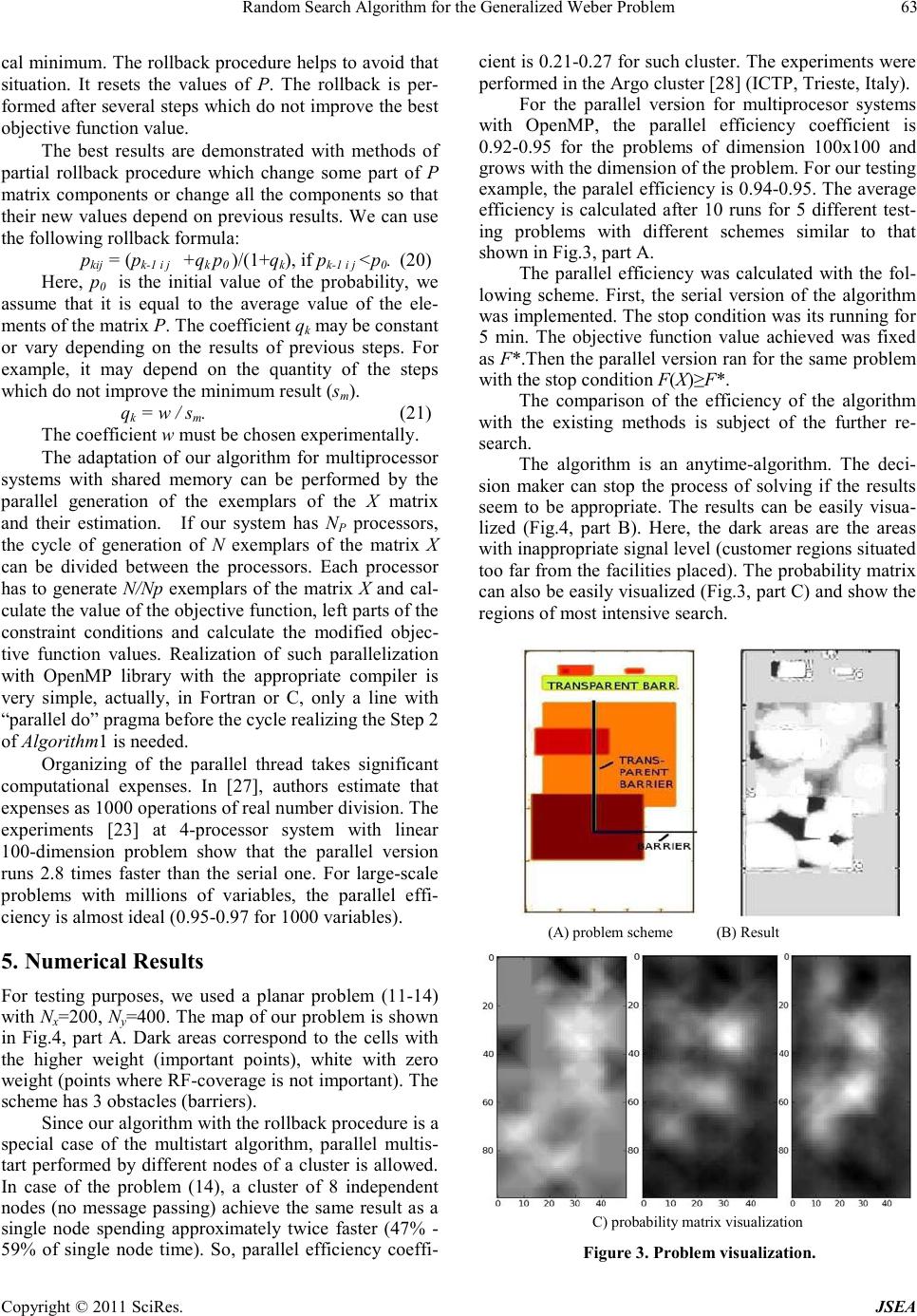 Random Search Algorithm for the Gen er alized Weber Problem Copyright © 2011 SciRes. JSEA 63 cal minimum. The rollback procedure helps to avoid that situation. It re sets the values of P. The rollback is per- formed after several steps which do not improve the best objective functi on value. The best results are demonstrated with methods of partial rollback procedure which change some part of P matri x compone nts or change all the co mponent s so that their new values depend on previous results. We can use the followin g rollback formula: pkij = (pk-1 i j +qk p0 )/(1+qk), if pk-1 i j <p0. (20) Here, p0 is the initial value of the probability, we assume that it is equal to the average value of the ele- ments of the matr ix P. The coefficient qk may be constant or vary depending on the results of previous steps. For example, it may depend on the quantity of the steps which do not improve the minimum result (sm). qk = w / sm. (21) The coefficient w must be chosen experimentally. The adaptation of our algorithm for multiprocessor systems with shared memory can be performed by the parallel generation of the exemplars of the X matrix and their estimation. If our system has NP processors, the cycle of generation of N exemplars of the matrix X can be divided between the processors. Each processor has to generate N/Np exemplars of the matrix X and cal- culate the value of the obj ective function, left parts of the constraint conditions and calculate the modified objec- tive function values. Realization of such parallelization with OpenMP library with the appropriate compiler is very simple, actually, in Fortran or C, only a line with “pa rallel do” pragma before the cycle realizing the Step 2 of Alg o rith m 1 is needed. Organizing of the parallel thread takes significant computational expenses. In [27], authors estimate that expense s as 1000 operations of real number division. The experiments [23] at 4-processor system with linear 100-dimension problem show that the parallel version runs 2.8 times faster than the serial one. For large-scale problems with millions of variables, the parallel effi- ciency is almo st ideal (0.95-0.97 for 1000 variables). 5. Numerical Results For testing purposes, we used a planar problem (11-14) with Nx=200, Ny=400. The map of our problem is shown in Fig.4, part A. Dark areas correspond to the cells with the higher weight (important points), white with zero weight (points where RF-cove rage is no t impor tant) . T he scheme has 3 obstacles (barriers). Since our algorith m with the rollback procedure is a special case of the multistart algorithm, parallel multis- tart performed by different nodes of a cluster is allowed. In case of the problem (14), a cluster of 8 independent nodes (no message passing) achieve the sa me result as a single node spending approximately twice faster (47% - 59% of single node time). So, parallel efficiency coeffi- cient is 0.21-0.27 for such cluster. The experiments were performed in the Ar go cluster [28] (ICTP, Trieste, Italy). For the parallel version for multiprocesor systems with OpenMP, the parallel efficiency coefficient is 0.92-0.95 for the problems of dimension 100x100 and grows with the dimension of the problem. For our testing example, the paralel efficiency is 0.94-0.95. The average efficiency is calculated after 10 runs for 5 different test- ing problems with different schemes similar to that shown in Fi g.3, part A. The parallel efficiency was calculated with the fol- lowing scheme. First, the serial version of the algorithm was i mplemented. The stop condition was its running for 5 min. The objective function value achieved was fixed as F*.T hen the parallel version ran for the same problem with the stop co nd ition F(X)≥F*. The comparison of the efficiency of the algorithm with the existing methods is subject of the further re- search. The algorithm is an anytime-algorithm. The deci- sion maker can stop the process of solving if the results seem to be appropriate. The results can be easily visua- lized (Fig.4, part B). Here, the dark areas are the areas with inapprop riate signal le vel ( custo mer regions situated too far fro m the facil ities place d). The probab ility matrix can also be easily visualized (Fig.3 , part C) and show the regions of most intensive sea rch. (A) problem scheme (B) Result C) probability matrix visualization Figure 3 . Problem visualization. 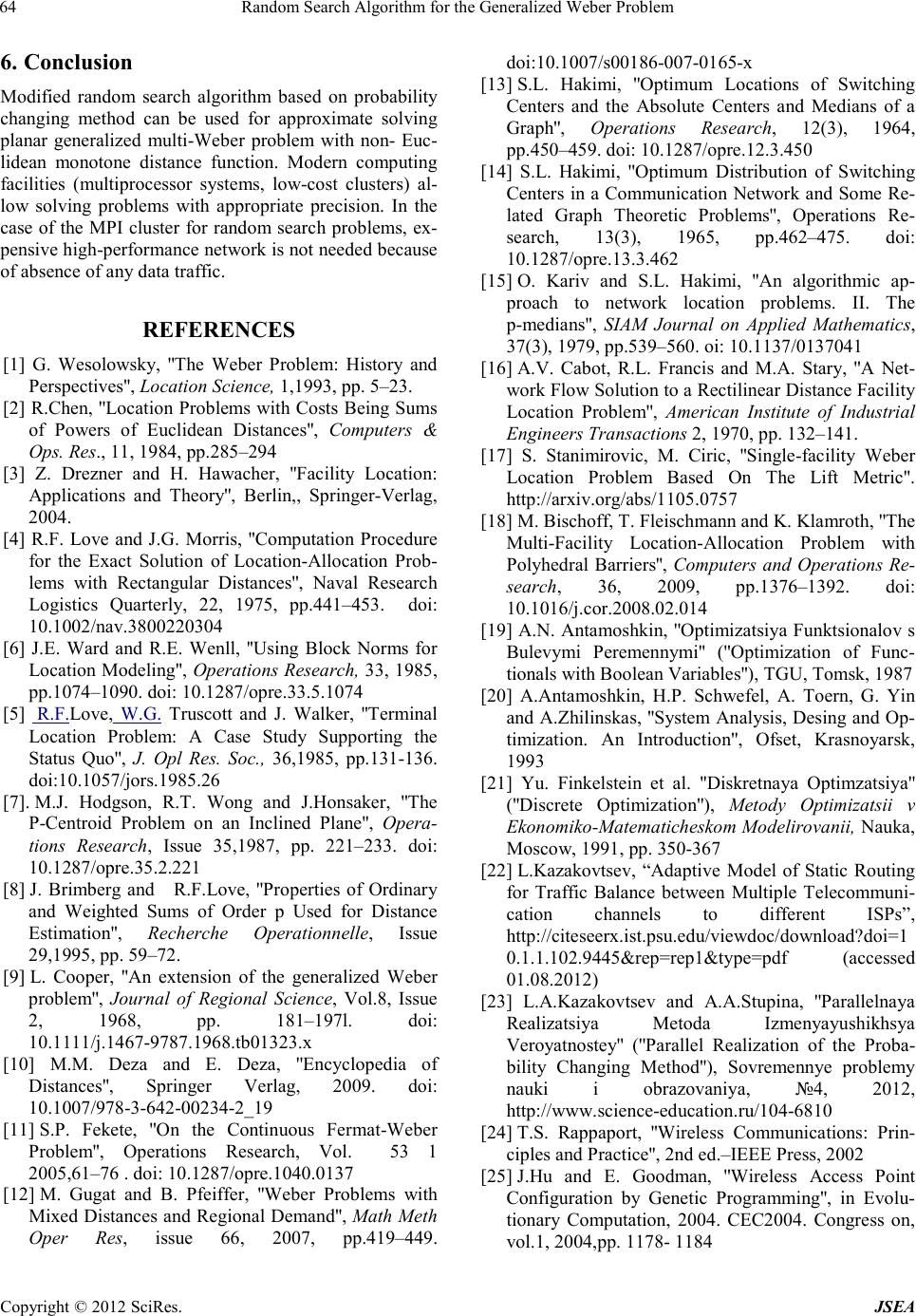 Random Search Algorithm for the Gen er alized Weber Problem Copyright © 2012 S ciRes. JSEA 64 6. Conclusion Modified random search algorithm based on probability changing method can be used for approximate solving planar generalized multi-Weber problem with non- Euc- lidean monotone distance function. Modern computing facilities (multiprocessor systems, low-cost clusters) al- low solving problems with appropriate precision. In the case of the MPI cluster for random search problems, ex- pensive high-performance network is not needed because of absence of any data tra ffic. REFERENCES [1] G. Wesolowsky, ''The Weber Problem: History and Perspectives'', Location Science, 1,1993, pp. 5–23. [2] R.Chen, ''Locatio n Problems wit h Costs Being Sums of Powers of Euclidean Distances'', Computers & Ops. Res., 11, 1984, pp.285–294 [3] Z. Drezner and H. Hawacher, ''Facility Location: Applications and Theory'', Berlin,, Springer-Verlag, 2004. [4] R.F. Love and J.G. Morris, ''Computation Procedure for the Exact Solution of Location-Allocation Prob- lems with Rectangular Distances'', Naval Research Logistics Quarterly, 22, 1975, pp.441–453. doi: 10.1002/nav.3800220304 [6] J.E. Ward and R.E. Wenll, ''Using Block Norms for Location Modeling'', Operations Research, 33, 1985, pp.1074–1090. doi: 10.1287/opre.33.5.1074 [5] R.F. Love, W.G. [12] M. Gugat and B. Pfeiffer, ''Weber Problems with Mixed Distanc es and Regiona l Dema nd'', Math Meth Oper Res, issue 66, 2007, pp.419–449. doi:10.1007/s00186-007-0165-x [13] S.L. Hakimi, ''Optimum Locations of Switching Centers and the Absolute Centers and Medians of a Graph'', Operations Research, 12(3), 1964, pp.450–459. doi: 10.1287/opre.12.3.450 [14] S.L. Hakimi, ''Optimum Distribution of Switching Centers in a Communication Network and Some Re- lated Graph Theoretic Problems'', Operations Re- search, 13(3), 1965, pp.462–475. doi: 10.1287/opre.13.3.462 [15] O. Kariv and S.L. Hakimi, ''An algorithmic ap- proach to network location problems. II. The p-medians'', SIAM Journal on Applied Mathematics, 37(3), 1979, pp. 5 39 –560. oi: 10.1137/0137041 [16] A.V. Cabot, R.L. Francis and M.A. Stary, ''A Net- work Flo w Solutio n to a Recti linear Di stance Fa cil it y Location Problem'', American Institute of Industrial Engineers Transactions 2, 1970, pp. 132–141. [17] S. Stanimirovic, M. Ciric, ''Single-facility Weber Location Problem Based On The Lift Metric''. http://arxiv.or g/abs/11 0 5 . 0 75 7 [18] M. Bischoff, T. Fleischmann and K . Klamroth, ''The Multi-Facility Location-Allocation Problem with Polyhedral Barriers'', Computers and Operations Re- search, 36, 2009, pp.1376–1392. doi: 10.1016/j.cor.2008.02.014 [19] A.N. Antamoshkin, ''Optimizatsiya Funktsionalo v s Bulevymi Peremennymi'' (''Optimization of Func- tionals with Boolean Variables''), TGU, Tomsk, 1987 [20] A.Antamoshkin, H.P. Schwefel, A. Toern, G. Yin and A.Zhilin skas, ''System Anal ysis, Desin g and Op- timization. An Introduction'', Ofset, Krasnoyarsk, 1993 [21] Yu. Finkelstein et al. ''Diskretnaya Optimzatsiya'' (''Discrete Optimization''), Metody Optimizatsii v Ekonomiko-Matematicheskom Modelirovanii, Nauka, Moscow, 1991, pp. 350-367 [22] L.Kazakovtsev, “Adaptive Model of Static Routing for Traffic Balance between Multiple Telecommuni- cation channels to different ISPs”, http://citeseer x.ist.psu.edu/vie wdo c/d ownload?doi= 1 0.1.1.102.9445&rep=rep1&type=pdf (accessed 01.08.2012) [23] L.A.Kazakovtsev and A.A.Stupina, ''Parallelnaya Realizatsiya Metoda Izmenyayushikhsya Veroyatnostey'' (''Parallel Realization of the Proba- bility Changing Method''), Sovremennye problemy nauki i obrazovaniya, №4, 2012, http://www.science-education.ru/104-6810 [24] T.S. Rappaport, ''Wireless Communications: Prin- ciples and Practice'', 2nd ed.–IEEE Press, 2002 [25] J.Hu and E. Goodman, ''Wireless Access Point Configuration by Genetic Programming'', in Evolu- tionary Computation, 2004. CEC2004. Congress on, vol.1, 2004,pp. 1178- 1184 Truscott and J. Walker, ''Terminal Location Problem: A Case Study Supporting the Status Quo'', J. Opl Res. Soc., 36,1985, pp.131-136. doi:10.1057/jors.1985.26 [7]. M.J. Hodgson, R.T. Wong and J.Honsaker, ''The P-Centroid Problem on an Inclined Plane'', Opera- tions Research, Issue 35,1987, pp. 221–233. doi: 10.1287/opre.35.2.221 [8] J. Brimberg and R.F.Love, ''Properties of Ordinary and Weighted Sums of Order p Used for Distance Estimation'', Recherche Operationnelle, Issue 29,1995, pp. 59–72. [9] L. Cooper, ''An extension of the generalized Weber problem'', Journal of Regional Science, Vol.8, Issue 2, 1968, pp. 181–197l. doi: 10.1111/j.1467-9787.1968.tb01323.x [10] M.M. Deza and E. Deza, ''Encyclopedia of Distances'', Springer Verlag, 2009. doi: 10.1007/978-3-642-00234-2_19 [11] S.P. Fekete, ''On the Continuous Fermat-Weber Problem'', Operations Research, Vol. 53 1 2005,61–76 . doi: 10.1287/opre.1040.0137 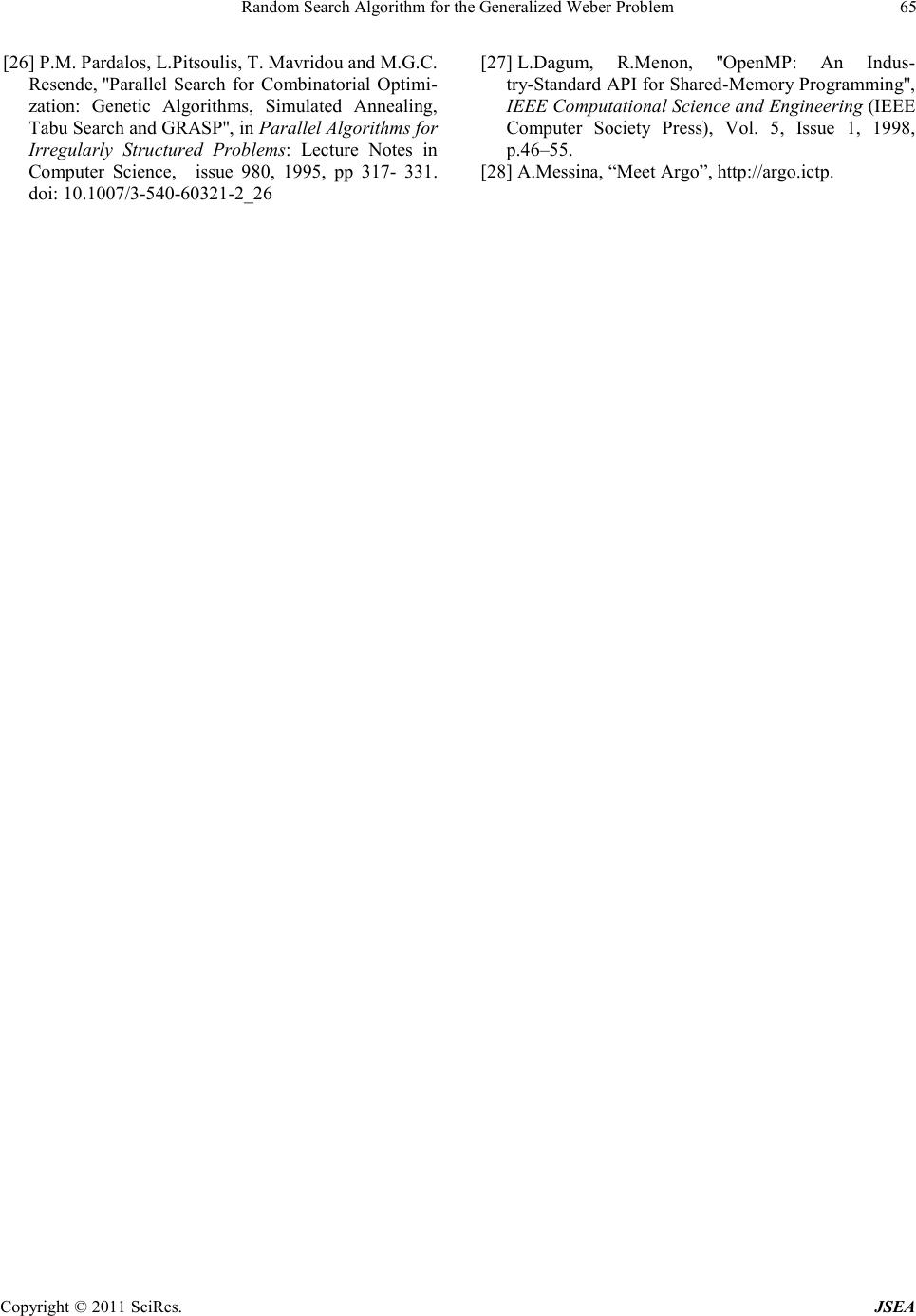 Random Search Algorithm for the Gen er alized Weber Problem Copyright © 2011 SciRes. JSEA 65 [26] P.M. Pardalos, L.Pitsoulis, T. Mavridou and M.G.C. Resende, ''Parallel Search for Combinatorial Optimi- zation: Genetic Algorithms, Simulated Annealing, Tabu Search and GRASP '', in Parallel A lgorithm s for Irregularly Structured Problems: Lecture Notes in Computer Science, issue 980, 1995, pp 317- 331. doi: 10.1007/3-540-60321-2_26 [27] L.Dagum, R.Menon, ''OpenMP: An Indus- try-Standard API for Shared-Memory Programming'', IEEE Computational Science and Engineering (IEEE Computer Society Press), Vol. 5, Issue 1, 1998, p.46–55. [28] A.Messina, “Meet Argo”, http://argo.ictp. |

